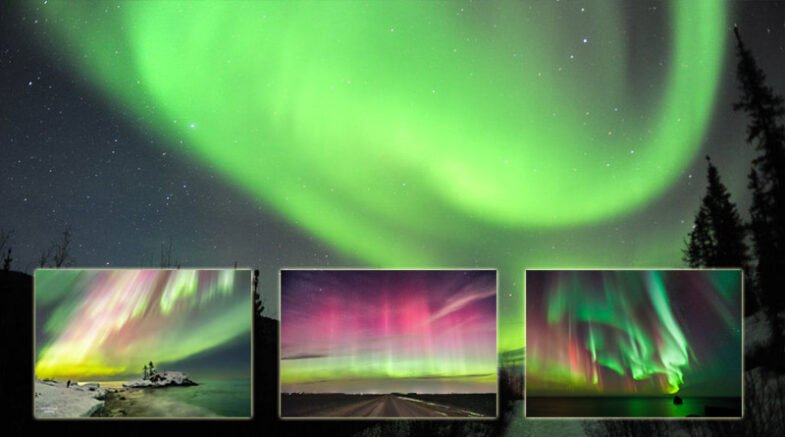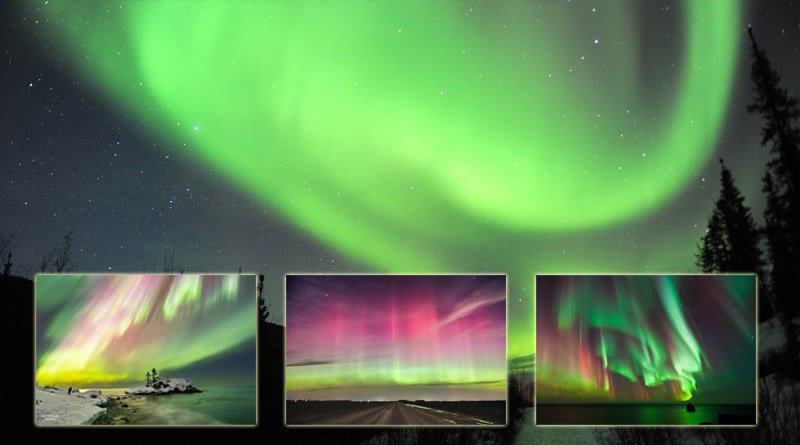The excess energy from the collision is released as brilliant light when these excited atoms eventually revert to their original ground state.

Night skies across the U.S. danced with streaks of green and magenta this past week due to a severe geomagnetic storm. People as far south as Asheville, N.C., and Phoenix, Ariz. had the unexpected pleasure of witnessing the Northern Lights.
Scott McIntosh, a solar physicist and deputy director of the National Center for Atmospheric Research, said it was “pretty special.” The severe geomagnetic storm was rated at level 4 on a five-point scale, and was the biggest storm in many years. In 2017, a similar storm caused auroras as far as Arkansas.
Auroras appear in the sky when charged particles ejected from the sun interact with Earth’s magnetic field. This field envelopes our planet in a protective bubble, but eruptions, flares, and holes on the sun’s surface can all unleash fast-moving particles that rattle our magnetic shield.
When this happens, electrons can surf the field straight down to Earth’s magnetic poles, according to Jim Schroeder, a plasma physicist at Wheaton College in Illinois.
Then, according to Schroeder, these charged particles “bounce around like a pinball, plunging deeper and deeper into the atmosphere.” They interact with and excite nitrogen and oxygen atoms inside the atmosphere.
The excess energy from the collision is released as brilliant light when these excited atoms eventually revert to their original ground state. Depending on the components and the speed of the initial collision, the light’s colour can range from a bright green to a deep magenta.
The “auroral ovals” that encircle the Arctic and Antarctic are where the lights typically appear. The auroral oval, however, can grow to cover a larger portion of the planet when these particles move farther away from the poles during strong storms.
In 2003, the eerie lights could be seen as far south as Florida on Halloween. The severe geomagnetic storm ever observed, in September 1859, caused auroras to light up the Caribbean.
The Southern Lights this past week extended further north, just as the Northern Lights did southward. The auroras were also seen by people in Tasmania, which is located at a latitude in the southern hemisphere similar to northern California in the northern hemisphere.
The auroras might appear more magenta than green when farther from the poles, according to MacDonald. This might be due to the fact that auroras usually appear red at higher atmospheric altitudes and green at lower altitudes.
Looking north, people in southern U.S. states like Arizona would have seen the lights, with the low-altitude green being obscured by the horizon due to the curvature of Earth. All that would be left would be a sinister magenta haze.
Anyone who saw an aurora is strongly encouraged to report that observation to Aurorasaurus, a citizen science project that MacDonald co-directs. The objective is to improve at predicting when and where the elusive phenomenon will appear by using sightings gathered from the general public.
Not just for the benefit of aurora chasers, scientists carefully monitor severe geomagnetic storms and auroral activity. Strong storms can disrupt power grids and pipelines, among other serious issues, on the ground.
“Some of our satellites keep an eye on the sun. But sometimes they are unable to see everything that is aimed at us, according to MacDonald. Officials typically have advance warning of storms a few days in advance. “In this instance, it wasn’t even close to that good.
McIntosh’s team is working to develop a technique that can detect when charged particles are headed towards Earth, giving scientists an earlier heads-up on stealthy storms. This could help them better forecast these events.
The recent storm was caused by a coronal mass ejection on the surface of the sun, which belched out giant loops of plasma. It may have been amplified by another solar phenomenon observed last week, called a coronal hole. These holes beam high-speed solar winds out into space.
The impact of all of these charged particles on the Earth’s magnetic field was “more than we anticipated,” according to Murtagh.
The magnetic fields of the particles and the magnetic field of Earth were “perfectly coupled,” and he laments the fact that such accidental couplings are “impossible to predict.” The season may have had an impact.
According to Pesnell, the tilt of the Earth’s magnetic field interacts particularly favourably with these charged particles from the sun around the spring and fall equinoxes.
Only three days had passed since the spring equinox when this storm struck. Bob Leamon, a solar physicist with NASA’s Goddard Space Flight Center, says, “It really was a confluence of everything falling into place at the right time.”
The sun is currently a hive of activity, and as its 11-year cycle nears its peak, it will only become more agitated.
The sun’s magnetic field will most likely reverse at that time, known as the solar maximum, in 2025. The sun’s cycle’s peak and its immediate aftermath will see the most intense activity. Despite how amazing it was last week, Leamon notes that we are still close to the solar maximum.
